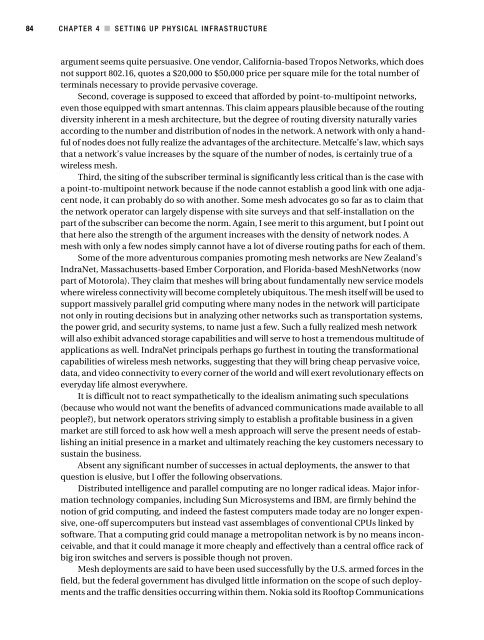WiMax Operator's Manual
WiMax Operator's Manual
WiMax Operator's Manual
Create successful ePaper yourself
Turn your PDF publications into a flip-book with our unique Google optimized e-Paper software.
84 CHAPTER 4 ■ SETTING UP PHYSICAL INFRASTRUCTURE<br />
argument seems quite persuasive. One vendor, California-based Tropos Networks, which does<br />
not support 802.16, quotes a $20,000 to $50,000 price per square mile for the total number of<br />
terminals necessary to provide pervasive coverage.<br />
Second, coverage is supposed to exceed that afforded by point-to-multipoint networks,<br />
even those equipped with smart antennas. This claim appears plausible because of the routing<br />
diversity inherent in a mesh architecture, but the degree of routing diversity naturally varies<br />
according to the number and distribution of nodes in the network. A network with only a handful<br />
of nodes does not fully realize the advantages of the architecture. Metcalfe’s law, which says<br />
that a network’s value increases by the square of the number of nodes, is certainly true of a<br />
wireless mesh.<br />
Third, the siting of the subscriber terminal is significantly less critical than is the case with<br />
a point-to-multipoint network because if the node cannot establish a good link with one adjacent<br />
node, it can probably do so with another. Some mesh advocates go so far as to claim that<br />
the network operator can largely dispense with site surveys and that self-installation on the<br />
part of the subscriber can become the norm. Again, I see merit to this argument, but I point out<br />
that here also the strength of the argument increases with the density of network nodes. A<br />
mesh with only a few nodes simply cannot have a lot of diverse routing paths for each of them.<br />
Some of the more adventurous companies promoting mesh networks are New Zealand’s<br />
IndraNet, Massachusetts-based Ember Corporation, and Florida-based MeshNetworks (now<br />
part of Motorola). They claim that meshes will bring about fundamentally new service models<br />
where wireless connectivity will become completely ubiquitous. The mesh itself will be used to<br />
support massively parallel grid computing where many nodes in the network will participate<br />
not only in routing decisions but in analyzing other networks such as transportation systems,<br />
the power grid, and security systems, to name just a few. Such a fully realized mesh network<br />
will also exhibit advanced storage capabilities and will serve to host a tremendous multitude of<br />
applications as well. IndraNet principals perhaps go furthest in touting the transformational<br />
capabilities of wireless mesh networks, suggesting that they will bring cheap pervasive voice,<br />
data, and video connectivity to every corner of the world and will exert revolutionary effects on<br />
everyday life almost everywhere.<br />
It is difficult not to react sympathetically to the idealism animating such speculations<br />
(because who would not want the benefits of advanced communications made available to all<br />
people?), but network operators striving simply to establish a profitable business in a given<br />
market are still forced to ask how well a mesh approach will serve the present needs of establishing<br />
an initial presence in a market and ultimately reaching the key customers necessary to<br />
sustain the business.<br />
Absent any significant number of successes in actual deployments, the answer to that<br />
question is elusive, but I offer the following observations.<br />
Distributed intelligence and parallel computing are no longer radical ideas. Major information<br />
technology companies, including Sun Microsystems and IBM, are firmly behind the<br />
notion of grid computing, and indeed the fastest computers made today are no longer expensive,<br />
one-off supercomputers but instead vast assemblages of conventional CPUs linked by<br />
software. That a computing grid could manage a metropolitan network is by no means inconceivable,<br />
and that it could manage it more cheaply and effectively than a central office rack of<br />
big iron switches and servers is possible though not proven.<br />
Mesh deployments are said to have been used successfully by the U.S. armed forces in the<br />
field, but the federal government has divulged little information on the scope of such deployments<br />
and the traffic densities occurring within them. Nokia sold its Rooftop Communications
















